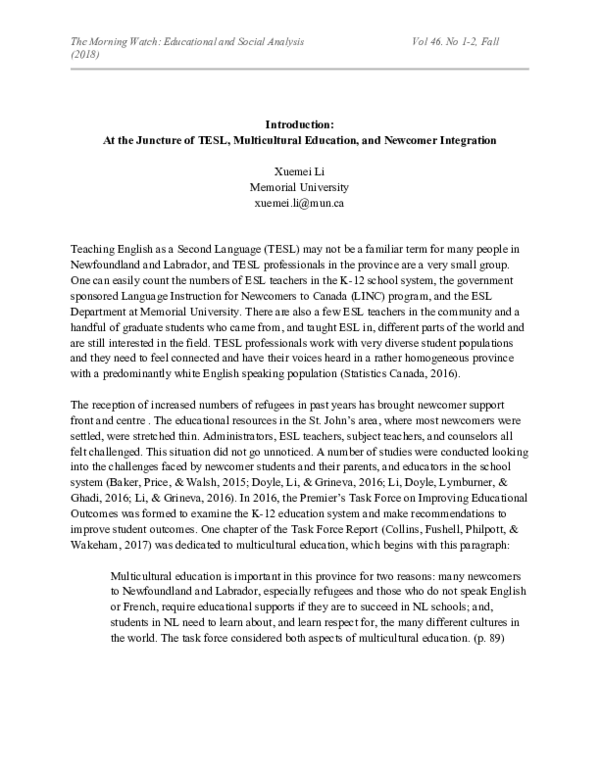Academia.edu no longer supports Internet Explorer.
To browse Academia.edu and the wider internet faster and more securely, please take a few seconds to upgrade your browser.
Introduction: At the Juncture of TESL, Multicultural Education, and Newcomer Integration
Introduction: At the Juncture of TESL, Multicultural Education, and Newcomer Integration
Related Papers
TESL Canada Journal
ESL Students Speak Up: Their Stories of How We are Doing1995 •
This study explores the ESL curriculum as experienced by students, casting light on their side of the story. We invited three Japanese secondary-level students to discuss their experience of learning English and analyzed their stories in terms of Schwab's four curriculum commonplaces (learner, subject matter, milieu, and teacher). Our analysis reveals that for the students, learning English has to do with negotiating their identities in a new environment. The current ESL curriculum as it focuses on the development of academic skills may not be providing enough support to help them integrate into the school community. In the absence of such support, some students may run the risk of perpetuating their marginality in the school and prematurely reaching a plateau in their English acquisition. Some practical ideas to promote integration, some of which are already implemented in Canadian schools, are discussed in the light of these findings.
Modern Language Journal
REVIEW OF: Teaching ESL/EFL Reading and Writing by NATION, I. S. P.� Teaching ESL/EFL Listening and Speaking by NATION, I. S. P., & JONATHAN NEWTON2010 •
2011 •
2016 •
This inquiry will be exploring the various teaching strategies that can best be deployed by educators to teach new immigrants to ease their journey into the classroom environment wherein they will be learning a new language. I will be looking at the phenomenon from the perspective of Anna (not real name) who arrives in the classroom with no prior English background. This research explores why Anna hated school, what went wrong and how it can be fixed so that other new immigrants and teachers will not encounter the same problem(s) in future.
Modern Language Journal
Teaching ESL/EFL Reading and Writing by NATION, I. S. P.� Teaching ESL/EFL Listening and Speaking by NATION, I. S. P., & JONATHAN NEWTON2010 •
Writing Program Administration 36.2
Students in the First-Year ESL Program: Revisiting the Notion of ‘Traditional’ ESL2013 •
An exponentially growing body of international undergraduate students in U.S. writing programs calls for the development of writing pedagogies that build on students’ composition literacy and their experiences in the authentic use of English. The implementation of this task requires an update of assumptions regarding international ESL students that is supported by data and takes into consideration the sociolinguistic realities of the global spread of English. This study investigated the characteristics of students enrolled in the ESL Writing Program at Purdue University. Through a questionnaire, the study documents student backgrounds, including their ESL characterization (international or U.S. resident); language backgrounds; academic literacy developed in native (L1) and U.S. educational contexts; instruction in L1 and English composition received in L1 educational contexts; as well as student motivation to register for an ESL composition course. Findings challenge the prevailing perception of international undergraduates as a homogeneous group of English language learners with limited experience in the authentic use of English and English composition. Implications for policies and practices of teaching composition are discussed.
TESOL in Context. Special Edition S3.
Coleman, J. (2012). The ESL teacher as ‘productive’ pedagogical mentor.2012 •
2023 •
This qualitative study delves into the strategies and experiences of ESL teachers in Multan, Pakistan, as they instruct students with diverse L1 backgrounds. Through interviews with 18 educators, the research identified key themes that illuminate effective ESL instruction. Notably, cultural sensitivity and awareness emerged as foundational, emphasizing the importance of acknowledging and celebrating students' cultural diversity. Adaptation of pedagogical approaches, flexibility in lesson planning, collaborative learning, and a commitment to continuous professional development are identified as pivotal components of successful ESL teaching. These findings align with established principles in ESL pedagogy, offering practical insights for educators and policymakers seeking to enhance ESL instruction in multicultural settings. The study underscores the significance of culturally responsive education in fostering language acquisition, intercultural understanding, and inclusive learning environments.
RELATED PAPERS
Quintana: revista do Departamento de Historia da Arte
Tránsitos musicales entre Colombia y Venezuela en el siglo XIX2021 •
2009 •
Environmental Modeling and Assessment
Water quality in the Elbe estuary: Significance of different processes for the oxygen deficit at Hamburg2020 •
Indian Journal of Forensic and Community Medicine
Impact of digital transformation in teaching and learning (TL) process of forensic medicine other medical subjects due to COVID 19 lockdown: Medical student’s perspective2021 •
European Journal of Political Economy
External influences on economic reform: Reform as a regional public good2007 •
International Journal of Veterinary Science and Research
Efficacy of Probiotic and Nitrifier Bacterial Consortium for the Enhancement of Litopenaeus Vannamei Aquaculture2016 •
Journal of interventional cardiac electrophysiology : an international journal of arrhythmias and pacing
Rationale and design of the TRICHAMPION trial: Triple Chamber Pacing in Hypertrophic Obstructive Cardiomyopathy Patients2018 •
Revista Sistemas de Producción Agroecológicos
Coeficiente de digestibilidad aparente de torta de algodón y harina de pescado en la alimentación de alevinos de tilapia roja (Oreochromis sp.)The Nordic Seminar on Computational Mechanics
Fracture Surface Morphology Under Ductile Tearing of Metal Plates2017 •

 Xuemei Li
Xuemei Li